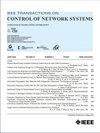车辆编队可伸缩性能闭环设计
IF 5
3区 计算机科学
Q2 AUTOMATION & CONTROL SYSTEMS
引用次数: 0
摘要
本文提出了一种新的车辆编队控制设计,作为通过传统共识协议对二阶系统进行对齐的替代方案。该设计是由闭环系统驱动的,我们将其构建为串联的一阶系统,因此称为串联共识。串行共识设计将保证闭环系统在包含有向生成树的底层通信图的最小要求下的稳定性,这是传统共识所不能实现的。作为我们的主要结果,我们证明了串行共识设计给出了最坏情况下队列瞬态行为的边界,该边界与车辆数量和底层图结构无关。特别是,这表明串行一致性设计保证了地层的管柱稳定性,因此适用于定向地层和通信拓扑结构。我们证明串行一致性可以通过消息传递或测量至多两跳的邻居来实现。我们通过数值例子来说明我们的结果。本文章由计算机程序翻译,如有差异,请以英文原文为准。
Closed-Loop Design for Scalable Performance of Vehicular Formations
This article presents a novel control design for vehicular formations as an alternative to alignment through conventional consensus protocols for second-order systems. The design is motivated by the closed-loop system, which we construct as first-order systems connected in series, and is therefore called serial consensus. The serial consensus design will guarantee the stability of the closed-loop system under the minimum requirement of the underlying communication graph containing a directed spanning tree, which is not generally true for conventional consensus. As our main result, we show that the serial consensus design gives bounds on the worst-case transient behavior of the formation, which is independent of the number of vehicles and the underlying graph structure. In particular, this shows that the serial consensus design guarantees the string stability of the formation and is, therefore, suitable for directed formations and communication topologies. We show that serial consensus can be implemented through message passing or measurements to neighbors at most two hops away. We illustrate our results through numerical examples.
求助全文
通过发布文献求助,成功后即可免费获取论文全文。
去求助
来源期刊

IEEE Transactions on Control of Network Systems
Mathematics-Control and Optimization
CiteScore
7.80
自引率
7.10%
发文量
169
期刊介绍:
The IEEE Transactions on Control of Network Systems is committed to the timely publication of high-impact papers at the intersection of control systems and network science. In particular, the journal addresses research on the analysis, design and implementation of networked control systems, as well as control over networks. Relevant work includes the full spectrum from basic research on control systems to the design of engineering solutions for automatic control of, and over, networks. The topics covered by this journal include: Coordinated control and estimation over networks, Control and computation over sensor networks, Control under communication constraints, Control and performance analysis issues that arise in the dynamics of networks used in application areas such as communications, computers, transportation, manufacturing, Web ranking and aggregation, social networks, biology, power systems, economics, Synchronization of activities across a controlled network, Stability analysis of controlled networks, Analysis of networks as hybrid dynamical systems.
 求助内容:
求助内容: 应助结果提醒方式:
应助结果提醒方式:


